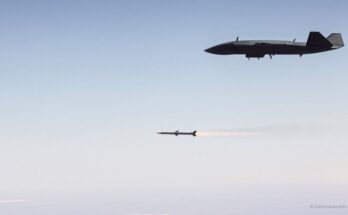The Indian Air Force will likely put a freeze on its plans to upgrade the engines on its four-decade-old SEPECAT Jaguar deep penetration strike fighter fleet and shift its efforts toward acquiring additional Sukhoi Su-30MKIs as a replacement.
The engine upgrade forms part of a larger effort aimed at keeping the Jaguar fleet serviceable and effective for an additional 20 years. That effort – the DARIN upgrade program – involves a comprehensive avionics upgrade and installation of an improved cockpit system.
Under a contract inked in December 2009, a total of 61 of the 123-aircraft Jaguar fleet are undergoing an upgrade from DARIN I to DARIN III avionics standard, but the project nonetheless remains well behind schedule (seven years behind, per reports). The DARIN upgrade program includes installation of the Display Attack Ranging Inertial Navigation (DARIN) III avionics suite, new AESA radar (Israel’s Elta ELM-2052), an all-glass cockpit, fly‑by-wire controls, and a new defensive aids suite.
The initial plan was to have the Jaguar upgrade completed by December 2017, with the modernized fleet remaining in service with the IAF beyond 2030. But state-owned Hindustan Aeronautics Ltd (HAL) has so far only delivered six upgraded prototypes after obtaining Initial Operational Clearance (IOC) in November 2016. With HAL struggling to integrate new radar on the jets, there has yet to be handover of a Final Operational Clearance (FOC) unit.
Meanwhile, the more crucial aspect is the under-performance of the Jaguars’ 1980s-vintage Rolls-Royce Adour Mk 811 turbofan engines. According to leaks from India’s defense establishment, the engines have experienced a 15 to 30 percent reduction in thrust. This reduction cripples the effectiveness of the Jaguar fleet, as the aircraft is no longer capable of carrying its full weapons load, a crucial element for a deep strike fighter that acts as the IAF’s primary nuclear delivery aircraft.
While the IAF had selected the F-125IN engine from U.S. company Honeywell as the upgrade alternative, the price tag for acquiring the engines and having HAL swap them onto the Jaguars is deemed too prohibitive.
The IAF, who is already short of 12 squadrons from its authorised fleet of 42, is now facing an even bigger aircraft shortfall as it abandons plan to upgrade 80 Jaguar fighters with new Honeywell engines@ajaishukla reports@IAF_MCC https://t.co/BhPkvsHd9l
— Business Standard (@bsindia) August 20, 2019
With funding pressures weighing on India’s broad modernization requirements, the IAF appears to be making a hard but practical choice to instead go with a fighter – the Su-30MKI – that would still adeptly fill the required role. But, as is often the case in Indian defense planning, the gap between reaching agreement with Ministry of Defence planners and then completing any procurement remains wide. Hence, there are no guarantees a quick-fix Su-30MKI order will become reality.
Dan Darling is Forecast International’s director of military and defense markets. In this role, Dan oversees a team of analysts tasked with covering everything from budgeting to weapons systems to defense electronics and military aerospace. Additionally, for over 17 years Dan has, at various times, authored the International Military Markets reports for Europe, Eurasia, the Middle East and the Asia-Pacific region.
Dan's work has been cited in Defense News, Real Clear Defense, Asian Military Review, Al Jazeera, and Financial Express, among others, and he has also contributed commentary to The Diplomat, The National Interest and World Politics Review. He has been quoted in Arabian Business, the Financial Times, Flight International, The New York Times, Bloomberg and National Defense Magazine.
In addition, Dan has made guest appearances on the online radio show Midrats and on The Media Line, as well as The Red Line Podcast, plus media appearances on France 24 and World Is One News (WION).



